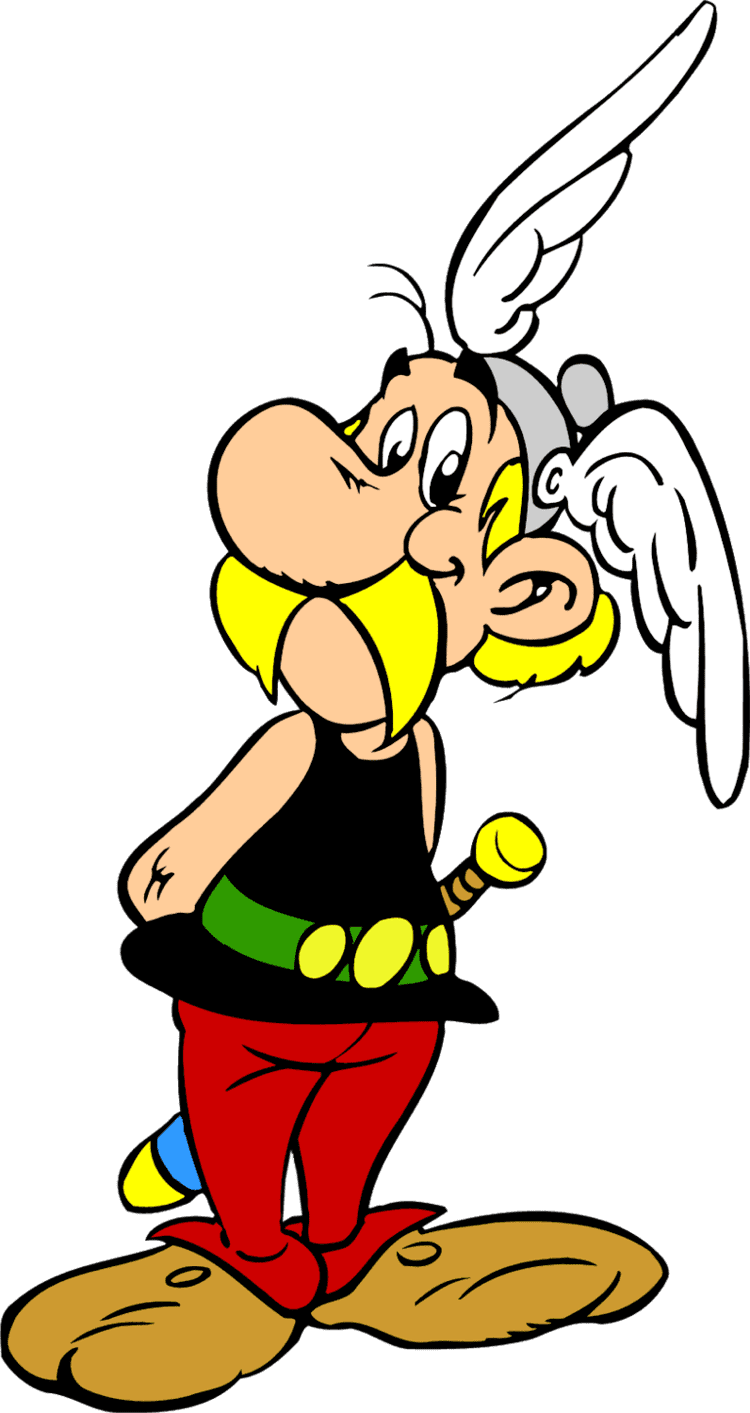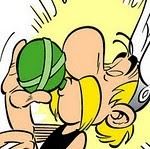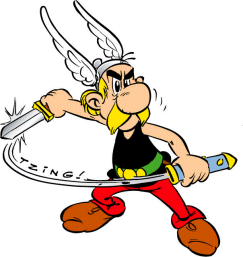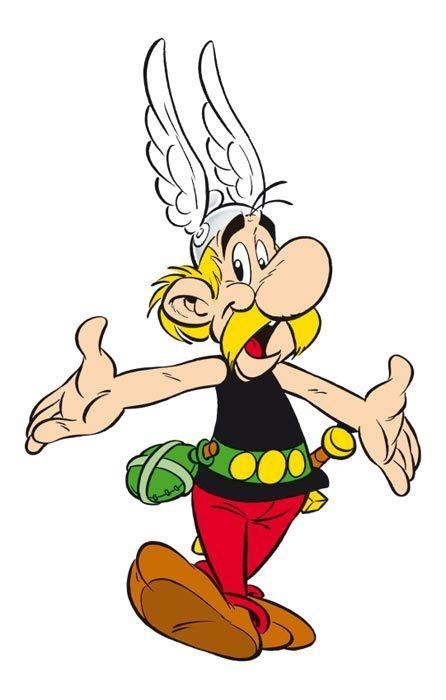Original title Astérix le Gaulois Genre Comedysatire Country France | Number of books 36 | |
 | ||
Illustrator Albert UderzoDidier Conrad (since 2013) Published 29 October 1959 – 22 October 2010(original period) Main characters Obelix, Asterix, Getafix, Dogmatix, Vitalstatistix, Assurancetourix, Impedimenta, Geriatrix, Cetautomatix Adaptations Asterix & Obelix: Mission Cleopatra (2002) Books Asterix the Gaul, Asterix and the Golden Sickle, Asterix and the Goths, Asterix the Gladiator, Asterix and the Banquet Similar The Adventures of Tintin, Lucky Luke, Oumpah pah Authors | ||
Asterix the gaul 1967
Asterix or The Adventures of Asterix (French: Astérix or Astérix le Gaulois, [asteʁiks lə ɡolwa]) is a series of French comics. The series first appeared in the Franco-Belgian comics magazine Pilote on 29 October 1959. It was written by René Goscinny and illustrated by Albert Uderzo until the death of Goscinny in 1977. Uderzo then took over the writing until 2009, when he sold the rights to publishing company Hachette. As of 2015, 36 volumes have been released.
Contents
- Asterix the gaul 1967
- History
- List of titles
- Synopsis and characters
- Humour
- Character names
- Ethnic stereotypes
- Translations
- English translation
- Adaptations
- Films
- Games
- Theme park
- Influence in popular culture
- References

The series follows the exploits of a village of indomitable Gauls as they resist Roman occupation. They do so by means of a magic Potion brewed by their druid, named Getafix in the English translations, which temporarily gives the recipient superhuman strength. The protagonists, the titular character Asterix, along with his friend Obelix have various adventures. The "ix" ending of both names (as well as all the other pseudo-Gaulish "ix" names in the series) alludes to the "rix" suffix (meaning "king") present in the names of many real Gaulish chieftains such as Vercingetorix, Orgetorix, and Dumnorix. (See below for further explanations of the character names.) Many of the stories have them travel to foreign countries, though others are set in and around their village. For much of the history of the series (Volumes 4 through 29), settings in Gaul and abroad alternated, with even-numbered volumes set abroad and odd-numbered volumes set in Gaul, mostly in the village.

The Asterix series is one of the most popular Franco-Belgian comics in the world, with the series being translated into over 100 languages, and it is popular in most European countries.

The success of the series has led to the adaptation of several books into 13 films: nine animated, and four live action. There have also been a number of games based on the characters, and a theme park near Paris, Parc Astérix. As of October 2009, 325 million copies of 34 Asterix books had been sold worldwide, making co-creators René Goscinny and Albert Uderzo France's bestselling authors abroad.

History

Prior to creating the Asterix series, Goscinny and Uderzo had previously had success with their series Oumpah-pah, which was published in Tintin magazine.

Astérix was originally serialised in Pilote magazine, in the very first issue published on 29 October 1959. In 1961 the first book was put together, titled Asterix the Gaul. From then on, books were released generally on a yearly basis. Their success was exponential; the first book sold 6,000 copies in its year of publication; a year later, the second sold 20,000. In 1963, the third sold 40,000; the fourth, released in 1964, sold 150,000. A year later, the fifth sold 300,000; 1966's Asterix and the Big Fight sold 400,000 upon initial publication. The ninth Asterix volume, when first released in 1967, sold 1.2 million copies in two days.

Uderzo's first sketches portrayed Asterix as a huge and strong traditional Gaulish warrior. But Goscinny had a different picture in his mind. He visualized Asterix as a shrewd small sized warrior who would prefer intelligence over strength. However, Uderzo felt that the small sized Hero needed a strong but dim companion to which Goscinny agreed. Hence, Obelix was born. Despite the growing popularity of Asterix with the readers, the financial backing for Pilote ceased. Pilote was taken over by Georges Dargaud.

When Goscinny died in 1977, Uderzo continued the series alone on the demand of the readers who implored him to continue. He continued the series but on a less frequent basis. Most critics and fans of the series prefer Goscinny's albums. Uderzo created his own publishing company, Les Editions Albert-René, which published every album drawn and written by Uderzo alone since then. However, Dargaud, the initial publisher of the series, kept the publishing rights on the 24 first albums made by both Uderzo and Goscinny. In 1990, the Uderzo and Goscinny families decided to sue Dargaud to take over the rights. In 1998, after a long trial, Dargaud lost the rights to publish and sell the albums. Uderzo decided to sell these rights to Hachette instead of Albert-René, but the publishing rights on new albums were still owned by Albert Uderzo (40%), Sylvie Uderzo (20%) and Anne Goscinny (40%).
In December 2008, Uderzo sold his stake to Hachette, which took over the company.

In a letter published in the French newspaper Le Monde in 2009, Uderzo's daughter, Sylvie, attacked her father's decision to sell the family publishing firm and the rights to produce new Astérix adventures after his death. She said "...the co-creator of Astérix, France’s comic strip hero, has betrayed the Gaulish warrior to the modern-day Romans – the men of industry and finance”. However, René Goscinny's daughter Anne also gave her agreement to the continuation of the series and sold her rights at the same Time. She is reported to have said that "Asterix has already had two lives: one during my father's lifetime and one after it. Why not a third?". A few months later, Uderzo appointed three illustrators, who had been his assistants for many years, to continue the series. In 2011, Uderzo announced that a new Asterix album was due out in 2013, with Jean-Yves Ferri writing the story and Frédéric Mébarki drawing it. A year later, in 2012, the publisher Albert-René announced that Frédéric Mébarki had withdrawn from drawing the new album, due to the pressure he felt in following in the steps of Uderzo. Comic artist Didier Conrad was officially announced to take over drawing duties from Mébarki, with the due date of the new album in 2013 unchanged.

In January 2015, after the murders of seven cartoonists at the satirical Paris weekly Charlie Hebdo, presumably for their controversial work, Astérix creator Albert Uderzo came out of retirement to draw two Astérix pictures honoring the memories of the victims.
List of titles
Numbers 1–24, 32 and 34 are by Goscinny and Uderzo. Numbers 25–31 and 33 are by Uderzo alone. Years stated are for their initial release. Numbers 35 and 36 are by Jean-Yves Ferri and Didier Conrad.
Asterix Conquers Rome is a comics adaptation of the animated film The Twelve Tasks of Asterix. It was released in 1976, and was the 23rd volume to be published, but it has been rarely reprinted and is not considered to be canonical to the series. The only English translations ever to be published were in the Asterix Annual 1980 and as a standalone volume in 1984.
In 2007, Les Editions Albert René released a tribute volume titled Astérix et ses Amis, a 60-page volume of one-to-four-page short stories. It was a tribute to Albert Uderzo on his 80th birthday by 34 European cartoonists. The volume was translated into nine languages. As of 2016, it has not been translated into English.
Synopsis and characters
The main setting for the series is an unnamed coastal village (rumoured to be inspired by Erquy) in Armorica (present-day Brittany), a province of Gaul (modern France), in the year 50 BC. Julius Caesar has conquered nearly all of Gaul for the Roman Republic. The little Armorican village, however, has held out because the villagers can gain temporary superhuman strength by drinking a magic potion brewed by the local village druid, Getafix. His chief is Vitalstatistix.
The main protagonist and hero of the village is Asterix, who, because of his shrewdness, is usually entrusted with the most important affairs of the village. He is aided in his adventures by his rather fat and slower thinking friend, Obelix, who, because he fell into the druid's cauldron of the potion as a baby, has permanent superhuman strength (because of this, Getafix steadily refuses to allow Obelix to drink the potion, as doing so would have a dangerous and unpredictable result). Obelix is usually accompanied by Dogmatix, his little dog. (Except for Asterix and Obelix, the names of the characters change with the language. For example, Obelix's dog's name is "Dogmatix" in English, but "Idéfix" in the original French edition.)
Asterix and Obelix (and sometimes other members of the village) go on various adventures both within the village and in far away lands. Places visited in the series include parts of Gaul (Lutetia, Corsica etc.), neighbouring nations (Belgium, Spain, Britain, Germany etc.), and far away lands (North America, Middle East, India etc.).
The series employs science-fiction and fantasy elements in the more recent books; for instance, the use of extraterrestrials in Asterix and the Falling Sky and the city of Atlantis in Asterix and Obelix All at Sea.
Humour
The humor in the Asterix comics primarily revolves around puns, caricatures, and playful stereotypes that reference contemporary European nations and French regions. Initially, much of the comic's humor was tailored specifically to a French audience, which initially hindered the translation of the books into other languages due to concerns about losing the essence of the jokes and the narrative. However, some translations have incorporated local humor to engage readers. For example, in the Italian version, Roman legionaries speak in a modern Roman dialect, and Obelix's catchphrase "Ils sont fous ces Romains" ("These Romans are crazy") is adapted to "Sono pazzi questi romani," cleverly nodding to the ancient Roman acronym SPQR. In another example: Hiccups are written onomatopoeically in French as "hips", but in English as "hic", allowing Roman legionaries in at least one of the English translations to decline their hiccups in Latin ("hic, haec, hoc"). The newer albums share a more universal humour, both written and visual.
Character names
All the fictional characters in Asterix have names which are puns on their roles or personalities and which follow certain patterns specific to nationality. Certain rules are followed (most of the time) such as Gauls (and their neighbours) having an '-ix' suffix for the males and ending in '-a' for the females, for example, Chief Vitalstatistix (so called due to his portly stature) and his wife Impedimenta (often at odds with the chief). The male Roman names end in '-us', echoing Latin nominitive male singular form, as in Gluteus Maximus, a muscle-bound athlete whose name is literally the butt of the joke. Gothic names (present-day Germany) end in "-ic", after Gothic chiefs such as Alaric and Theoderic, for example Rhetoric the interpreter. Greek names end in "-os" or "-es"; for example, Thermos the restaurateur. British names end in "-ax" and are often puns on the taxation associated with the later United Kingdom, such as Valuaddedtax the druid and Selectivemploymentax the mercenary. Other nationalities are treated to pidgin translations from their language, like Huevos y Bacon, a Spanish chieftain (whose name, meaning eggs and bacon, is often guidebook Spanish for tourists) or literary and other popular media references, like Dubbelosix (a reference to James Bond's codename 007).
Most of these jokes, and hence the names of the characters, are specific to the translation, for example, the druid Getafix is Panoramix in the original French and Miraculix in German. Even so, occasionally the wordplay has been preserved: Obelix's dog, known in the original French as Idéfix (from idée fixe, a "fixed idea" or obsession), is called Dogmatix in English, which not only renders the original meaning strikingly closely ("dogmatic") but in fact adds another layer of wordplay with the syllable "Dog-" at the beginning of the name.
The name Asterix, French Astérix, comes from astérisque, meaning "asterisk", which is the typographical symbol * indicating a footnote, from the Greek word αστήρ (aster), meaning a "star". His name is usually left unchanged in translations, aside from accents and the use of local alphabets. For example, in Esperanto, Polish, Slovene, Latvian, and Turkish it is Asteriks (in Turkish he was first named Bücür meaning "shorty", but the name was then changed). Two exceptions include Icelandic, in which he is known as Ástríkur ("Rich of love") and Sinhalese, where he is known as සූර පප්පා (Soora Pappa), which can be interpreted as "Hero".
For explanations of some of the other names, see List of Asterix characters.
Ethnic stereotypes
Many of the Asterix adventures take place in other countries aside from their homeland, Gaul. In every album that takes place abroad they meet (usually modern-day) stereotypes for each country as seen by the French.
When the Gauls see foreigners speaking their foreign languages, these have different representation in the speech bubbles:
Translations
The various volumes have been translated into more than 100 languages and dialects. Besides the original French language, most albums are available in Estonian, English, Czech, Dutch, German, Galician, Danish, Icelandic, Norwegian, Swedish, Finnish, Spanish, Catalan, Basque, Portuguese, Italian, modern Greek, Hungarian, Polish, Romanian, Turkish, Slovene, Bulgarian, Serbian, Croatian, Latvian, Welsh as well as Latin.
Some albums have also been translated into languages such as Esperanto, Scottish Gaelic, Scots, Indonesian, Persian, Mandarin, Korean, Japanese, Bengali, Afrikaans, Arabic, Hindi, Hebrew, Frisian, Romansch, Vietnamese, Sinhalese, Ancient Greek and even Luxembourgish.
In France, Finland, and especially in Germany, several volumes were translated into a variety of regional languages and dialects, such as Alsatian, Breton, Chtimi (Picard) and Corsican in France, Bavarian, Swabian and Low German in Germany, and Savo, Karelia, Rauma and Helsinki slang dialects in Finland. Also, in Portugal, a special edition of the first volume, Asterix the Gaul, was translated into local language Mirandese. In Greece, a number of volumes have appeared in the Cretan Greek, Cypriot Greek and Pontic Greek dialects. In the Italian version, while the Gauls speak standard Italian, the legionaries speak in the Romanesque dialect. In former Yugoslavia, "Forum" publishing house translated Corsican in "Asterix in Corsica" into Montenegrin dialect of Serbo-Croatian (today called Montenegrin language).
In the Netherlands several volumes were translated into Frisian, a language related to English spoken in the province of Friesland, into Limburgish, a regional language spoken not only in Dutch Limburg but also in Belgian Limburg and North Rhine-Westphalia, Germany and into Tweants, a dialect in the region of Twente in the eastern province of Overijssel. Hungarian-language books have been issued in Yugoslavia for the Hungarian minority living in Serbia. Although not a fully autonomous dialect, it slightly differs from the language of the books issued in Hungary. In Sri Lanka, the cartoon series was adapted into Sinhala (Singhalese) as Sura Pappa, the only Sri Lankan translation of a foreign cartoon that managed to keep the spirit of the original series intact.
Most volumes have been translated into Latin and Ancient Greek with accompanying teachers' guides as a way of teaching these ancient languages.
English translation
The translation of the books into English has been done by Derek Hockridge and Anthea Bell, and their English language rendition has been widely praised for maintaining the spirit and humour of the original French version.
Adaptations
The series has been adapted into various media.
Films
Various motion pictures based upon the series have been made.
Games
Many gamebooks, board games and video games are based upon the Asterix series. In particular, many video games were released by various computer game publishers.
Theme park
Parc Astérix, a theme park 22 miles north of Paris, based upon the series, was opened in 1989. It is one of the most visited sites in France, with around 1.6 million visitors per year.
